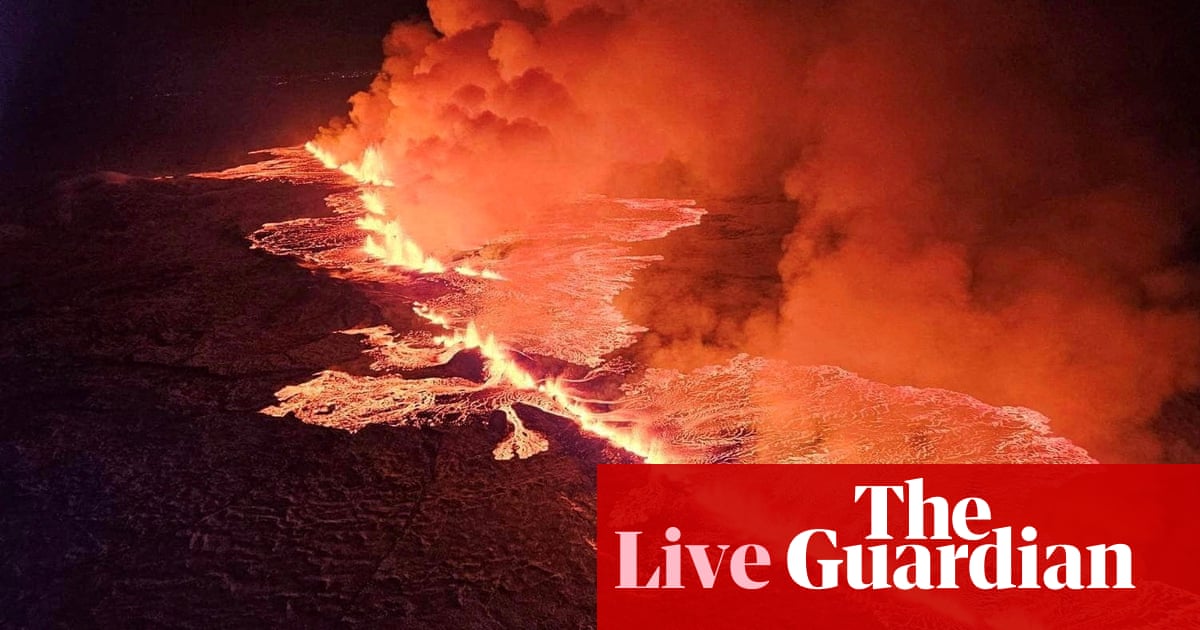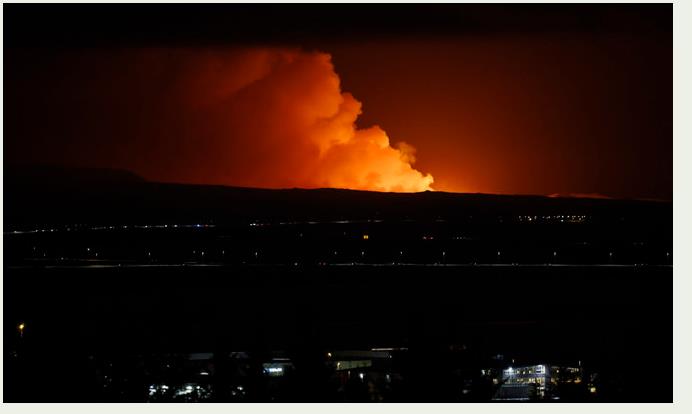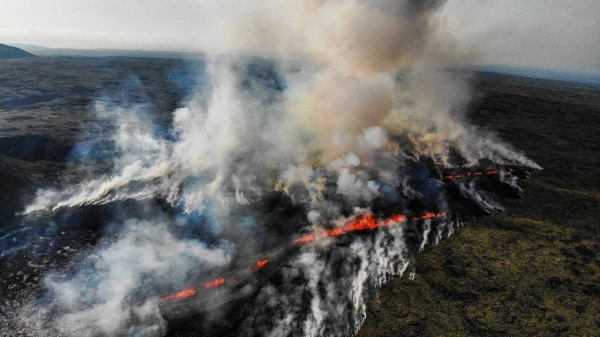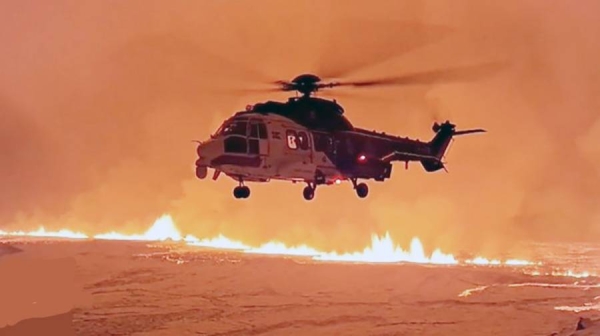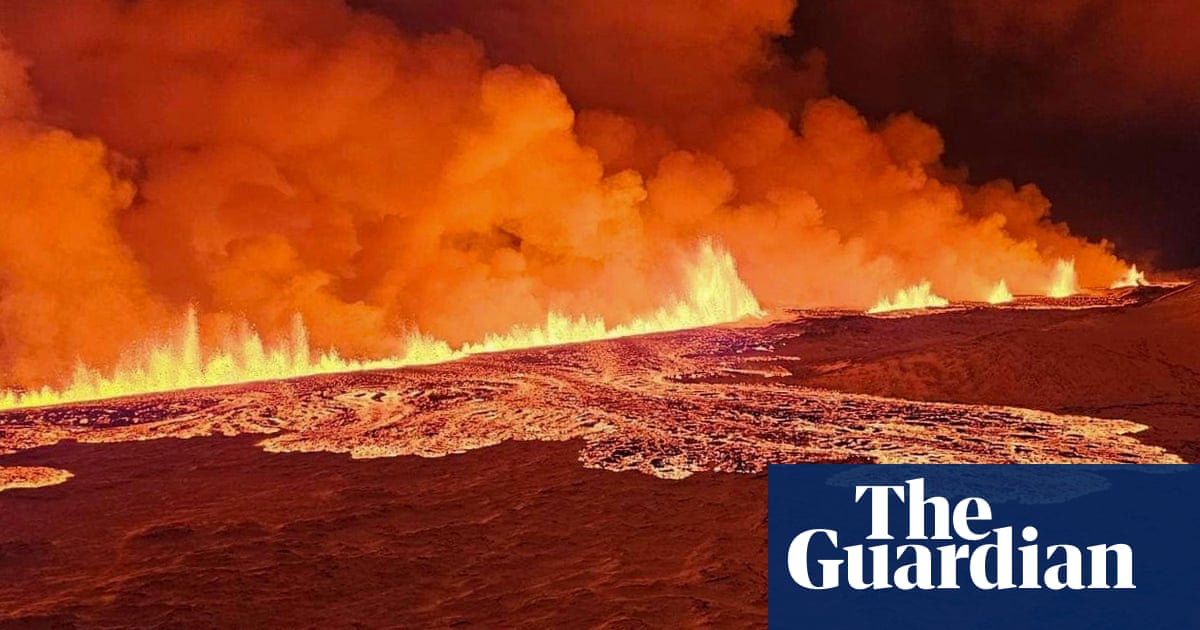
A volcano on the Reykjanes peninsula in south-west Iceland has erupted after weeks of intense earthquake activity, spewing glowing orange jets of lava surrounded by billowing clouds of red smoke.
“Warning: eruption has started north of Grindavík by Hagafell,” the meteorological office said on its website on Monday. The eruption started a few kilometres from Grindavík, a fishing town located about 25 miles (40km) south-west of Iceland’s capital, Reykjavík. The town with a population of 4,000 was evacuated in November after the area was hit by a “seismic swarm” of more than 1,000 small earthquakes in 24 hours.
The government on Tuesday said the eruption did not present a threat to life, adding that there were no disruptions to flights to and from Iceland, while international flight corridors remained open.
Although unlikely, as this type of eruption does not usually produce much ash, experts said there could yet be some effect on air travel.
Describing the style of eruption as “amongst the most spectacular ever seen”, Matthew Watson, professor of volcanoes and climate at the University of Bristol, said: “There will be a strong pull for tourists Tourists should strictly follow official advice as there are significant hazards, such as new breakouts, which can quickly put people in harm’s way.”
The eruption began at about 10.17pm local time after a series of small earthquakes at about 9pm, the met office said.
Iceland’s prime minister, Katrín Jakobsdóttir, said her thoughts were with the people of Grindavík “now we see the Earth opening up”.
“Our thoughts are with the local people as before, we hope for the best, but it can be clear that this is quite an eruption. It is important to give emergency responders space to do their work and follow traffic instructions.”
Iceland’s president, Guðni Th. Jóhannesson, said: “Our priorities remain to protect lives and infrastructure. Civil defence has closed off the affected area. We now wait to see what the forces of nature have in store. We are prepared and remain vigilant.”
Images and livestreams by the local news outlet RUV showed lava spewing from fissures in the ground, which on Monday night travelled more than 100 metres (330ft) into the air.
The Icelandic met office initially said the magma was moving to the south-west and that the eruption might continue in the direction of Grindavík. Then, the crack in the Earth’s surface was about 2.1 miles long and had grown rapidly.
Between 100 and 200 cubic metres (3,530 and 7,060 cubic ft) of lava was emerging per second, several times more than in previous eruptions in the area.
But by late morning on Tuesday, lava from the eruption appeared to be flowing away from the town, offering hope that homes that have survived the weeks of earthquakes in Grindavík might be spared.
The southernmost point of the fissure – which had since grown to 4km (2.5 miles) long – was still 3km away from Grindavík, the met office said.
“The eruption is taking place north of the watershed, so lava does not flow towards Grindavík,” geologist Bjorn Oddson told public broadcaster RUV.
Local police said they had raised their alert level as a result of the eruption and the country’s civil defence advised the public not to approach the area while emergency personnel assessed the situation.
Reykjavík’s international airport, which is located nearby, remained open albeit with numerous delays listed for arrivals and departures.
Iceland’s foreign minister, Bjarni Benediktsson, said on X there were “no disruptions to flights to and from Iceland and international flight corridors remain open”.
Several eruptions have occurred in unpopulated areas in recent years on the Reykjanes peninsula, but the latest outbreak could pose a risk to Grindavík, authorities have said.
Since November’s evacuation order people have been allowed to return to their homes between 7am and 9pm each day, and some businesses have reopened. People have not been allowed to stay overnight or walk around the town.
Before Monday night’s eruption they had been waiting for an update this week to find out whether the evacuation rules would be lifted in time for Christmas. Thousands of quakes have occurred in the area in the past two months, but magnitudes were declining in recent weeks, leading some experts to think the risk of an eruption had abated.
Many from the town are struggling amid housing shortages, and some are angry that they are still not allowed to stay in their homes overnight.
According to local reports one person who lives in Grindavík was recently threatened with arrest after breaking the rules to stay at home with his wife for several nights.
The Blue Lagoon spa, one of the country’s most popular tourist attractions, reopened on Sunday for the first time in more than a month – despite the fears of a potential volcanic eruption. At the time management said the decision was made in “close collaboration with the authorities”.
On Tuesday another statement was released saying it had once again closed.
Reykjanes is a volcanic and seismic hotspot. In March 2021, lava fountains erupted spectacularly from a 500- to 750-metre-long (1,640- to 2,460ft-long) fissure in the ground in the Fagradalsfjall volcanic system.
Iceland is home to 33 active volcano systems, the highest number in Europe.




